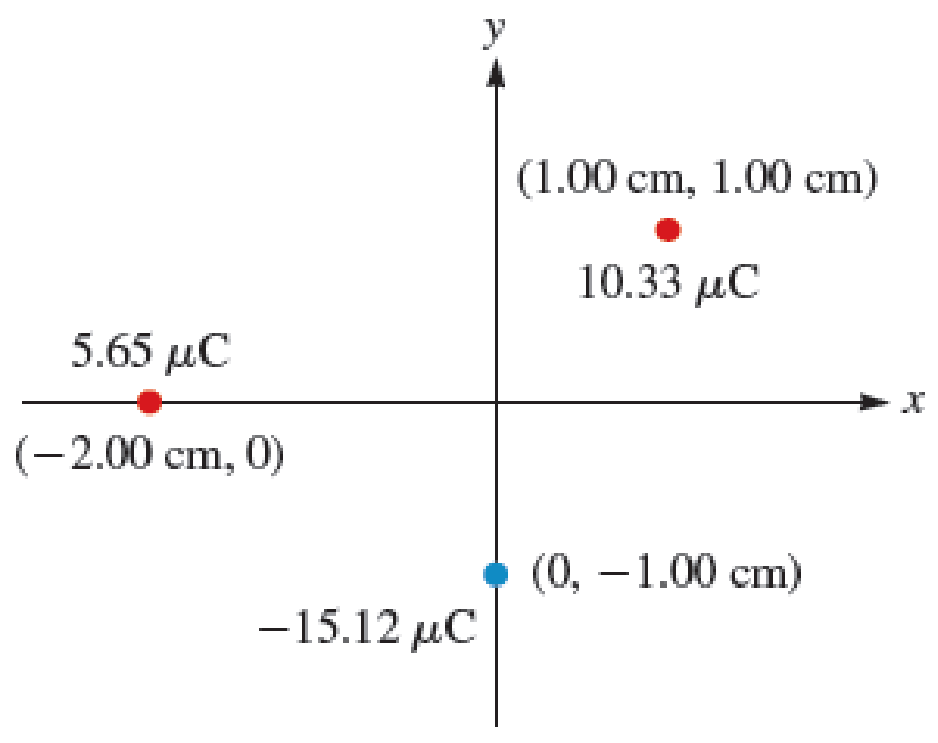
Concept explainers
Given the arrangement of charged particles in Figure P23.38, find the net electrostatic force on the 10.33-μC charged particle.

The net-electrostatic force on
Answer to Problem 39PQ
The net-electrostatic force on
Explanation of Solution
The diagram for the charges.

Write the expression for Coulomb’s law.
Here,
Write the distance between the charges
Here,
Write the equation for distance between the charges
Here,
Write the equation for angle between lines of particle with charge
Here,
Write the equation for angle between lines of particle with charge
Here,
Since, both the particles with charges
Write the expression to find the electrostatic force by particles
Here,
Substitute
Since, the particle
Write the expression to find the electrostatic force by particles
Here,
Substitute
The net-electrostatic force on
Write the expression to find the net-electrostatic force on
Here,
Conclusion:
Substitute
Therefore, the net-electrostatic force on
Want to see more full solutions like this?
Chapter 23 Solutions
Physics for Scientists and Engineers: Foundations and Connections
- Given the arrangement of charged particles in Figure P23.38, find the net electrostatic force on the 5.65-C charged particle.arrow_forwardThree charged particles are arranged in the xy plane as shown in Figure P23.61, with qA = 6.40 C, qB = 2.30 C, and qC = 3.80 C. What is the net electrostatic force on the particle with charge qA? Figure P23.61arrow_forwardCharges A, B, and C are arranged in the xy plane with qA = 5.60 C, qB = 4.00 C, and qC = 2.30 /C (Fig. P23.43). What are the magnitude and direction of the electrostatic force on charge B? Figure P23.43arrow_forward
- A Figure P23.65 shows two identical conducting spheres, each with charge q, suspended from light strings of length L. If the equilibrium angle the strings make with the vertical is , what is the mass m of the spheres? Figure P23.65arrow_forwardA Two positively charged particles, each with charge Q, are held at positions (a, 0) and (a, 0) as shown in Figure P23.73. A third positively charged particle with charge q is placed at (0, h). a. Find an expression for the net electric force on the third particle with charge q. b. Show that the two charges Q behave like a single charge 2Q located at the origin when the distance h is much greater than a. Figure P23.73 Problems 73 and 74.arrow_forwardIn Figure P24.49, a charged particle of mass m = 4.00 g and charge q = 0.250 C is suspended in static equilibrium at the end of an insulating thread that hangs from a very long, charged, thin rod. The thread is 12.0 cm long and makes an angle of 35.0 with the vertical. Determine the linear charge density of the rod. FIGURE P24.49arrow_forward
- Three charged metal spheres are arrayed in the xy plane so that they form an equilateral triangle (Fig. P23.40). What is the net electrostatic force on the sphere at the origin? Figure P23.40arrow_forwardA 1.75-nC charged particle located at the origin is separated by a distance of 0.0825 m from a 2.88-nC charged particle located farther along the positive x axis. If the 1.75-nC particle is kept fixed at the origin, where along the positive x axis should the 2.88-nC particle be located so that the magnitude of the electrostatic force it experiences is twice as great as it was in Problem 27?arrow_forwardThree charged spheres are at rest in a plane as shown in Figure P23.70. Spheres A and B are fixed, but sphere C is attached to the ceiling by a lightweight thread. The tension in the string is 0.240 N. Spheres A and B have charges qA = 28.0 nC and qB = 28.0 nC. What charge is carried by sphere C?arrow_forward
- Three point charges are located on a circular arc as shown in Figure P22.19. (a) What is the total electric field at P, the center of the arc? (b) Find the electric force that would be exerted on a 5.00-nC point charge placed at P. Figure P22.19arrow_forwardThree particles with charges of 1.0 C, 1.0 C, and 0.50 C are placed at the corners A, B, and C of an equilateral triangle with side length 0.10 m as shown in Figure P23.72. Find the net force on the charge at point C.arrow_forwardA uniformly charged insulating rod of length 14.0 cm is bent into the shape of a semicircle as shown in Figure P23.45. The rod has a total charge of 7.50 C. Find (a) the magnitude and (b) the direction of the electric field at O, the center of the semicircle.arrow_forward
 Physics for Scientists and Engineers: Foundations...PhysicsISBN:9781133939146Author:Katz, Debora M.Publisher:Cengage Learning
Physics for Scientists and Engineers: Foundations...PhysicsISBN:9781133939146Author:Katz, Debora M.Publisher:Cengage Learning Physics for Scientists and EngineersPhysicsISBN:9781337553278Author:Raymond A. Serway, John W. JewettPublisher:Cengage Learning
Physics for Scientists and EngineersPhysicsISBN:9781337553278Author:Raymond A. Serway, John W. JewettPublisher:Cengage Learning Physics for Scientists and Engineers with Modern ...PhysicsISBN:9781337553292Author:Raymond A. Serway, John W. JewettPublisher:Cengage Learning
Physics for Scientists and Engineers with Modern ...PhysicsISBN:9781337553292Author:Raymond A. Serway, John W. JewettPublisher:Cengage Learning Physics for Scientists and Engineers, Technology ...PhysicsISBN:9781305116399Author:Raymond A. Serway, John W. JewettPublisher:Cengage Learning
Physics for Scientists and Engineers, Technology ...PhysicsISBN:9781305116399Author:Raymond A. Serway, John W. JewettPublisher:Cengage Learning College PhysicsPhysicsISBN:9781285737027Author:Raymond A. Serway, Chris VuillePublisher:Cengage Learning
College PhysicsPhysicsISBN:9781285737027Author:Raymond A. Serway, Chris VuillePublisher:Cengage Learning College PhysicsPhysicsISBN:9781305952300Author:Raymond A. Serway, Chris VuillePublisher:Cengage Learning
College PhysicsPhysicsISBN:9781305952300Author:Raymond A. Serway, Chris VuillePublisher:Cengage Learning





